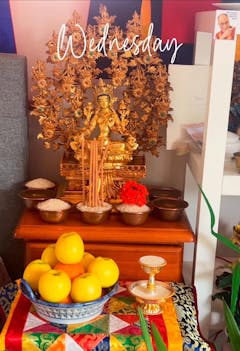Tantric Deity Machig Labdron Statue | Hand-Carved Spiritual Sculpture
Hand-Carved Dakini Kurukulla Statue | Buddhist Goddess Sculpture
Oxidized Vajrayogini Statue | Handmade Buddhist Icon for Worship
Vajrayogini Statue with Oxidized Finish | The Diamond Female Yogi
Vajrayogini Statue: Exquisite Buddhist Art for Meditation
Vajrayogini Buddhist Statue | Wrathful Dakini for Spiritual Empowerment
Kurukulla Statue | Handcrafted Wrathful Goddess of Magnetizing Power
Dakini: wrathful Goddess of Vajrayana
Dakini, the wrathful goddess of Vajrayana is a powerful symbol of wisdom, transformation and divine feminine energy in Buddhism and Hinduism. In Sanskrit her name means "sky dancer" and Tibetan she guides practitioners on their spiritual journey. Dakinis appear in various forms fierce, nurturing or playful and are central to Tantric traditions aiding in enlightenment.
In Himalayan art, Dakinis are depicted in intricate statues showcasing their dynamic and protective nature. In Japan they are linked to mystical foxes and called Shinko'ō or Kiko Tennō. A Dakini statue is a sacred addition to meditation spaces, embodying wisdom and transformation.
Dorje Phagmo
Dorje Phagmo also known as Vajravārāhī is a revered Tibetan Buddhist goddess symbolizing wisdom, compassion and power. As the root of all dakini emanations, she plays a key role in Vajrayana traditions paired with Hayagriva in the Nyingma school and Heruka Cakrasaṃvara in the Cakrasaṃvara Tantra. She is portrayed as a red-skinned, dancing figure, holding a skull cup and curved knife wearing tiger skins to signify her ability to subdue negativity. Handmade Dakini statues beautifully captures her fierce energy making it a sacred addition to meditation spaces.
Kurukulla
Kurukulla is a revered figure in Tibetan Buddhism, known as the "Red Tara" or "Dakini of Magic". She is often depicted as a youthful radiant goddess with a red complexion symbolizing her power to attract and subdue. Kurukulla typically holds a bow and arrow made of flowers representing her ability to pierce through obstacles and delusions. She is also associated with a hook which she uses to draw beings toward enlightenment. Her major symbols include the lotus and the utpala flower signifying purity and spiritual awakening. Kurukulla figurine is called upon for rituals related to love, magnetism and overcoming negative forces.
Machig Labdron
Machig Labdron was a renowned Tibetan yogini and the founder of the Chöd practice. He is a powerful meditation technique for cutting through ego and fear. She is portrayed as a wisdom Dakini holding a damaru (hand drum) and a bell symbolizing the union of wisdom and compassion. With her flowing white robes and serene yet fierce expression she embodies the essence of enlightened feminine energy. Also known as an emanation of Yeshe Tsogyal, she is deeply venerated in Tibetan Buddhism. Explore our handcrafted sculpture of Machig Labdron to enhance your spiritual space.
Namgyalma
Namgyalma, also known as Ushnisha Vijaya is a revered goddess in Tibetan Buddhism symbolizing long life, purification and wisdom. She is typically shown with three faces and eight arms holding sacred objects like vajra and lotus representing her power to remove obstacles and grant blessings. Her radiant white body signifies purity and spiritual awakening making her a powerful deity for those seeking protection and longevity. Explore the sacred Namgyalma, another divine feminine figure to enrich your spiritual practice.
Saraswati
Saraswati is revered as the goddess of wisdom, music, and learning in both Hinduism and Buddhism. She is also known as Yangchenma in Tibetan Buddhism. She is portrayed as a graceful figure dressed in white, symbolizing purity and knowledge, often holding a veena (lute), scriptures, and a rosary, representing art, wisdom, and spiritual power. Saraswati’s presence is believed to inspire creativity and intellect. Bring the divine Saraswati Statue into your space to elevate the powerful goddess of wisdom.
Simha Mukha Dakini
Simha Mukha Dakini, also known as the Lion-Faced Dakini is a fierce embodiment of wisdom and protection in Tibetan Buddhism. She is recognized by her lion's head which symbolizes fearlessness and the power to overcome negativity. With a vibrant blue or red body she holds a curved knife and a skull cup representing the destruction of ignorance and the transformation of obstacles into wisdom. Singha Mukha is revered for her ability to dispel fears and negative forces making her an important deity in Vajrayana practice. Enhance your sacred space with a handmade spiritual idol of Simha Mukha Dakin bringing strength and divine energy into your surroundings.
Vajrayogini
Vajrayogini is a fierce and enlightened goddess in Tibetan Buddhism symbolizing ultimate wisdom and spiritual transformation. Also known as Vajravarahi is often shown with a red body standing in a dancing posture holding a curved knife and skull cup representing the cutting of ignorance and the realization of emptiness. Her powerful presence helps practitioners overcome obstacles on their spiritual journey. For those seeking a divine touch in their sacred space, handcrafted Vajrayogini statues brings powerful energy and spiritual inspiration.






































































